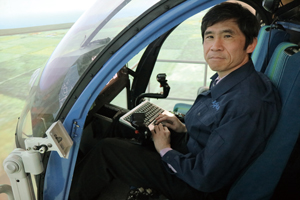About us
JAXA Aviation helps to create a safer and more prosperous society with aeronautics-related research and development activities.
FLIGHT PATH No.21 | 2018 SUMMER
<People>
Human factors for flight safety
Could you tell us a bit about your current research?

FUNABIKI Kouhei
Manager, Flight Research Unit
Photo:Funabiki adjusting a device in FSCAT-R, JAXA flight simulator for helicopter
We research human engineering in the broad sense for aviation technology, called “human factors.” Human engineering is a discipline that solves issues and problems by considering the relationships between people and machines, such as flight instrument types and yoke shapes. “Human factors” has a slightly broader meaning. We work to resolve challenges in collaboration with different fields like psychology, physiology, medicine, electronic engineering, and flight dynamics.
Specifically, this research includes the Tunnel-in-the-Sky Display system, which was also used in FQUROH project flight tests as well as SAVERH, which supports safe helicopter operation. We frequently use simulators for specific purposes to conduct experiments on and analyze issues related to aviation human factors based on requests from other projects and parties outside of JAXA.
Until around 1980, the main issues in human engineering were related to gauge visibility and aircraft maneuverability. However, our themes have been greatly transformed as these problems have been resolved with improved computer performance and new techniques like fly-by-wire. Since then, different topics are drawing attention like automation and crewmember communication. Initiatives are launched across the world to take on these topics whenever a major aviation accident occurs.
Did you dream of working in the aviation field as a child?
I think I liked airplanes, but I didn’t particularly aspire to the aviation field. I worked with robots for my graduation thesis, when I researched an artificial arm operated by sensors on the legs. I hoped to find a job at a national research institution, but back then the National Aerospace Laboratory of Japan (NAL)—the predecessor to JAXA’s Aviation Technology Directorate—was recruiting human engineering researchers, and I got involved in that research.
What difficulties did you encounter when you started your career in the aviation field?
I knew absolutely nothing about aircraft, so I had to start from scratch to learn about aerodynamics and other related topics. Luckily, I had many opportunities to fly with research aircraft starting from my first year, which gave me lots of up-close experience of aviation technology. My first task was to build a helicopter simulator, and I remember learning a great deal from senior employees and other people.
What has been your most memorable experience?
I was involved in investigating the China Airlines flight that crashed at Nagoya Airport in 1994. I realized that technology used to build aircraft is just one part of aviation technologies, which was something I had a vague understanding of at the time. This experience personally showed me that many elements must be in balance—such as aircraft design, manufacturing, certification, operation, and air traffic control—and that a small imbalance can lead to an accident or major incident. I am very impressed that this accident evoked discussions across the world on new standards related to the relationship between aircraft automation systems and flight crews.
What advice do you have for people who want to work in the aviation field?
At the JAXA Aviation Technology Directorate, research and aircraft operations are connected, so we have immediate access to high-quality resources and social needs. We can promptly conduct flight tests to confirm our research. I hope that passionate young people from various fields will take on many new challenges here.
Interviewee: FUNAKI Funabiki, Manager, Flight Research Unit
Graduated from the Department of Mechanical Engineering, Waseda University in 1989. Completed the master’s course of the Department of Mechanical Engineering, the University of Tokyo in 1991, and joined the National Aerospace Laboratory of Japan (NAL) the same year. Was a visiting researcher at the German Aerospace Center (DLR) from 1998 to 1999.